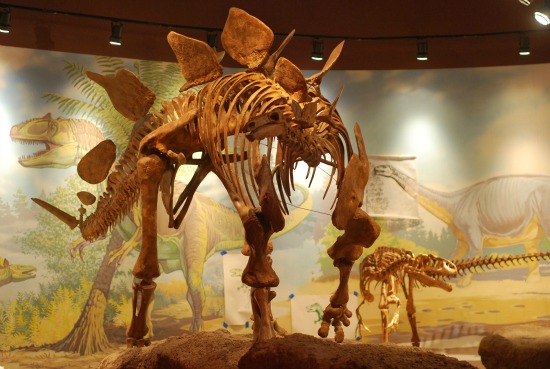The Double Dinosaur Brain Myth
Contrary to a popular myth, dinosaurs didn’t have butt brains
![]()

Contrary to a popular myth, Stegosaurus did not a have a butt brain. Photo by the author at the Utah Field House of Natural History in Vernal, Utah.
There’s no shortage of dinosaur myths. Paleontologist Dave Hone recently compiled a list of eight persistent falsehoods over at the Guardian–from the misapprehension that all dinosaurs were huge to the untenable idea that Tyrannosaurus could only scavenge its meals–but there was one particular misunderstanding that caught my attention. For decades, popular articles and books claimed that the armor-plated Stegosaurus and the biggest of the sauropod dinosaurs had second brains in their rumps. These dinosaurs, it was said, could reason “a posteriori” thanks to the extra mass of tissue. It was a cute idea, but a totally wrong hypothesis that actually underscores a different dinosaur mystery.
Dinosaur brain expert Emily Buchholtz outlined the double brain issue in the newly-published second edition of The Complete Dinosaur. The idea stems from the work of 19th-century Yale paleontologist Othniel Charles Marsh. In an assessment of the sauropod Camarasaurus, Marsh noticed that the canal in the vertebrae over the dinosaur’s hips enlarged into an expanded canal that was larger than the cavity for the dinosaur’s brain. “This is a most suggestive fact,” he wrote, and, according to Buchholtz, in 1881 Marsh described a similar expansion in the neural canal of Stegosaurus as “a posterior braincase.”
Sauropods and stegosaurs seemed like the perfect candidates for butt brains. These huge dinosaurs seemed to have pitiful brain sizes compared to the rest of their body, and a second brain–or similar organ–could have helped coordinate their back legs and tails. Alternatively, the second brain was sometimes cast as a kind of junction box, speeding up signals from the back half of the body up to the primary brain. That is, if such an organ actually existed. As paleontologists now know, no dinosaur had a second brain.
There are two intertwined issues here. The first is that many dinosaurs had noticeable expansions of their spinal cords around their limbs–a feature that left its mark in the size of the neural canal in the vertebrae. This isn’t unusual. As biologists have discovered by studying living species, the enlargement of the spinal cord in the area around the limbs means that there was a greater amount of nervous system tissue in this area, and dinosaurs with larger expansions around the forelimb, for example, probably used their arms more often than dinosaurs without the same kind of enlargement. The expansion of the neural canal can give us some indication about dinosaur movement and behavior.
But the so-called “sacral brain” is something different. So far, this distinct kind of cavity is only seen in stegosaurs and sauropods and is different than the typical expansion of the neural canal. There was something else, other than nerves, filling that space. Frustratingly, though, we don’t really know what that something is.
At the moment, the most promising idea is that the space was similar to a feature in the hips of birds called the glycogen body. As sauropod expert Matt Wedel has pointed out, this space stores energy-rich glycogen in the hips. Perhaps this was true for the sauropods and stegosaurs, too. Again, though, we hit a snag. We don’t really know what the glycogen body does in birds–whether it helps with balance, is a storehouse for nutritious compounds that are drawn upon at specific times or something else. Even if we assume that the expansion in dinosaurs was a glycogen body, we don’t yet know what biological role the feature played. Dinosaurs didn’t have hindbrains, but the significant spaces in the hips of stegosaurs and sauropods still puzzle paleontologists.
/https://tf-cmsv2-smithsonianmag-media.s3.amazonaws.com/accounts/headshot/RileyBlack.png)
/https://tf-cmsv2-smithsonianmag-media.s3.amazonaws.com/accounts/headshot/RileyBlack.png)